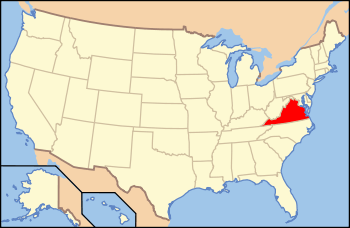Farmington (Albemarle County, Virginia)
|
Farmington | |
|
Farmington, HABS Photo | |
  | |
| Location | West of the junction of US 250 and US 29, Charlottesville, Virginia |
|---|---|
| Coordinates | 38°03′44.27″N 78°32′30.10″W / 38.0622972°N 78.5416944°WCoordinates: 38°03′44.27″N 78°32′30.10″W / 38.0622972°N 78.5416944°W |
| Area | 10 acres (4.0 ha) |
| Built | 1780 |
| Architectural style | Early Republic, Other, Jeffersonian |
| NRHP Reference # | 70000782[1] |
| VLR # | 002-0035 |
| Significant dates | |
| Added to NRHP | September 15, 1970 |
| Designated VLR | July 7, 1970[2] |
Farmington is a house near Charlottesville, in Albemarle County, Virginia, that was greatly expanded by a design by Thomas Jefferson that Jefferson executed while he was President of the United States. The original house was built in the mid-18th century for Francis Jerdone on a 1,753-acre (709 ha) property. Jerdone sold the land and house to George Divers, a friend of Jefferson, in 1785. In 1802, Divers asked Jefferson to design an expansion of the house. The house, since greatly enlarged, is now a clubhouse.
Description
The Jefferson addition comprises the present building's main facade, consisting of an elongated octagon with its long axis perpendicular to the large tetrastyle Tuscan portico. The original house was a two-story, three-bay brick house over a basement with a side-hall plan. There were two rooms above and below. Jefferson's addition is to the east. The addition's portico extends for two stories in front of three main bays, with the entry door centered, flanked by typical Jefferson triple-hung windows extending to the floor. The door and windows are crowned by round windows lighting the upper level. To either side are projecting half-octagon wings with windows matching the central portion. In Jefferson's design and as built, the long octagon was divided into two unequal rooms. The interior was greatly altered following a mid-19th century fire, with the creation of a central hall and a second floor over all. When the property became a country club the second floor was removed in 1929 and the three spaces were combined into a single space. The house was greatly enlarged to the rear with service, dining and accommodation spaces.[3][4]
Influence
Farmington was extensively studied by University of Virginia architectural historian Fiske Kimball, who adapted the design for his own residence, Shack Mountain, now a National Historic Landmark.[5]
Farmington was placed on the National Register of Historic Places on September 15, 1970.[1]
References
- 1 2 National Park Service (2010-07-09). "National Register Information System". National Register of Historic Places. National Park Service.
- ↑ "Virginia Landmarks Register". Virginia Department of Historic Resources. Retrieved 2013-05-12.
- ↑ Virginia Historic Landmarks Commission Staff (May 13, 1970). "National Register of Historic Places Inventory - Nomination Form: Farmington" (PDF). National Park Service. Retrieved 21 October 2011.
- ↑ Wilson, Richard Guy, ed. (2002). The Buildings of Virginia:Tidewater and Piedmont. Oxford University Press. ISBN 0-19-515206-9.
- ↑ Virginia Historic Landmarks Commission Staff (June 1976). "National Register of Historic Places Inventory - Nomination Form: Shack Mountain" (PDF). National Park Service. Retrieved 21 October 2011.
External links
- Farmington, U.S. Route 250 vicinity, Charlottesville vicinity, Albemarle, VA at the Historic American Buildings Survey (HABS)
.jpg)

